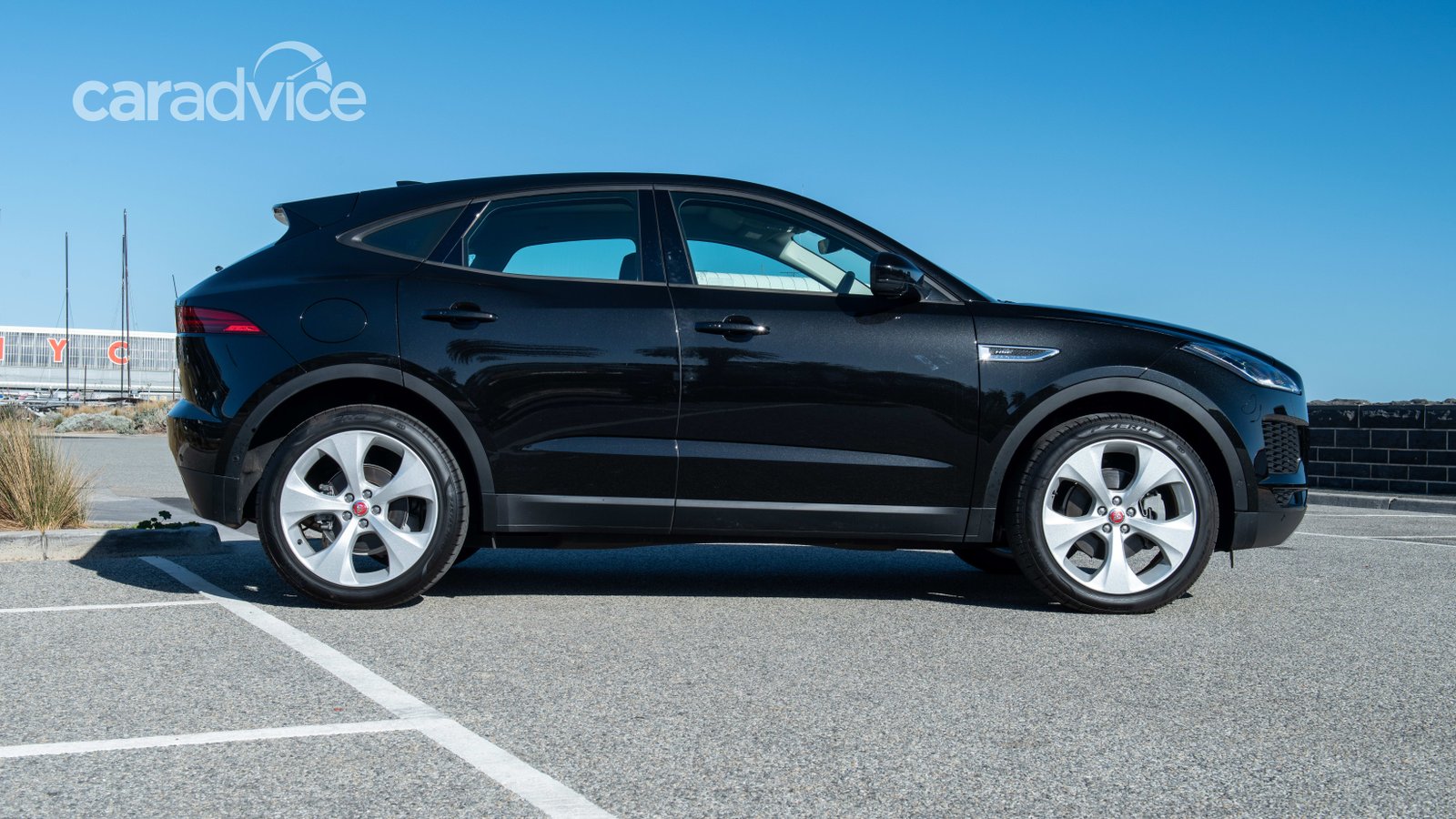[bsa_pro_ad_space id=14]
The Jaguar E-Pace doesn’t lack presence, and there’s something for everyone in the range. So is the D180 worth a look?
What constitutes ‘fashionably’ late? The first BMW X1 lobbed in 2009, and the Mercedes-Benz GLA arrived in 2014, by which time the world’s luxury carmakers were all working flat out to develop a compact SUV of their own.
It took until July 2017, a whopping eight years after the X1 launched, for Jaguar to join the party. That’s too long for the E-Pace to be considered fashionably late. The littlest Jaguar arrived after the speeches. It rolled in after the cake had been cut. You get the idea.
Jaguar hasn’t arrived empty-handed, though: there are a dizzying five engine grades and nine trim variants, opening the door for 38 different trim combinations in Australia. The 2018 Jaguar E-Pace HSE D180 we have here has the mid-range diesel engine (the D180 part) and most expensive trim pack (that’s the HSE bit) for a starting price of $67,990 before on-roads.
Size-wise, it’s larger than the Q2 and X1, but smaller than genuine mid-sized SUVs like the Audi Q5 and BMW X3, for a segment-straddling physical and price presence.
Some of our previous E-Pace testers have come with terrifying options lists, but whoever specced this D180 showed impressive restraint. With a panoramic glass roof ($2160), additional power sockets ($260) and Santorini Black paint ($1370) fitted as options, the as-tested sticker runs to $71,780 before on-road costs.
You actually get a pretty handy list of standard equipment in the HSE. Outside, the car rides on 20-inch alloy wheels, and there are LED headlights with ‘signature’ running lights, twin tailpipes, auto-dimming and power-folding mirrors, a gesture/powered tailgate and rear fog lights.
Inside, the top-spec HSE comes with 18-way electric front seats – finished in black – and a leather steering wheel.
Jaguar’s higher-end 10.0-inch Touch Pro infotainment system along with blind-spot monitoring, a rear-view camera, adaptive cruise, high-speed emergency braking, lane-keep assist, parking assist, a 360-degree surround-view monitor and a digital driver display are all standard.
Rounding out the standard equipment list is keyless entry, an alarm, a wireless hotspot and Meridian audio. Warranty is the three-year (100,000km) period offered across the Jaguar range, while servicing is required every 12 months or 26,000km.
With such a long list of inclusions, and a price starting with seven, you could be forgiven for expecting a properly opulent interior. Unfortunately, the E-Pace is less than the sum of its parts from behind the wheel. It’s visually boring, with swathes of black leather and plastic combining to deliver an overwhelmingly dour feeling.
The steering wheel feels cheap, which is just inexcusable, and the rotary climate controls lack the tactility we’ve come to expect from BMW, let alone the touchpoint kings at Audi.
Sure, the dash itself has the same grab handle and sloping airbag cover as the F-Type, but it just doesn’t feel interesting or special compared to the BMW X2 (which can be had with burnt-orange leather) or Audi Q2 (a meticulously crafted technology showcase).
There are a few nice touches, though: the drive mode selector and shifter have been nicked from the F-Type, and the seating position is genuinely excellent, with enough adjustment to sit even the tallest drivers on the floor. The front pews are a real highlight, and held up well on a pair of hour-long airport runs.
Jaguar isn’t known for infotainment leadership, but the E-Pace is passable (if not class-leading) on the technology front. The digital driver readout is clear and offers enough glitz to keep technophiles happy, while the central touchscreen has a clean interface and responds promptly.
It looks a bit Fisher-Price compared to the Germans, though, and getting your phone contacts to sync is more difficult than it really ought to be. Oh, and Apple CarPlay/Android Auto are both conspicuously absent, both from the standard equipment or options lists.
We suspect the upcoming Mercedes-Benz GLA will make the entire class look very old-hat with its dual-screen MBUX system when it launches, not that it’s really fair to compare current models with an as-yet unreleased rival.
At least the Jaguar is practical, with 484L of boot space with the second row seats in place and 1141L with them folded. The chunky exterior means there’s plenty of leg and head room for second-row passengers, even with a tall driver up front. Rear occupants are treated to air vents, too.
The littlest cat easily accounted for the BMW X2 on the rear-seat space front in our recent comparison, and would have the GLA comfortably covered as well.
It’s not just the styling that’s chunky. Jaguar was late to the compact-SUV game, but it still didn’t have the time to develop bespoke underpinnings for the E-Pace, instead building it around the architecture from the Evoque and Discovery Sport. Because of that, it weighs 1843kg in D180 form.
These are millennial-oriented cars, so we’ll use a millennial-friendly term. In any spec, the E-Pace is a ‘thicc boi’.
“Would we like it to be lighter? Of course, but I guess when we started this project four years ago, we wanted to get this vehicle to market as quickly as possible, because naturally, we were really keen for a small SUV, as a cheaper entry point for the customer,” Alan Volkaerts, vehicle line director, told us at launch.
“We didn’t want to take it off the aluminium architecture of the larger F-Pace, because that would have put it in the wrong price bracket for us, so we chose to go with that from the Range Rover Evoque and Land Rover Discovery Sport models.
“That meant it was an inherently steel platform, at least to begin with.”
Claimed economy is 5.6L/100km on the combined cycle, and you’ll actually get close to that on the highway, but expect to see closer to 8.0L or 9.0L/100km around town. Just imagine how much more efficient it’d be with, say, 300kg less to lug.
The transmission isn’t the decisive, slick-shifting partner required in this car. It’s laggy around town, and is easily confused in situations where, say, the eight-speeder used in most BMWs would simply drop a gear and get on with things.
Once you’re up to speed it’s fairly unobtrusive, but occasionally refuses to kick down, instead bogging down until you’ve put the throttle through the carpet.
With the needle in the sweet spot – let’s say between 1750 and 3500rpm – the D180 feels fairly swift, offering plenty of confidence for higher-speed overtakes. There isn’t too much diesel clatter, either, even if you’re pushing toward the redline. As we’ve pointed out in previous reviews, the E-Pace is a happy highway cruiser.
Despite its heft, there’s actually a bit for keener drivers in the E-Pace chassis as well. You don’t get a heap of feedback through the steering wheel, but the rack is quick and the nose surprisingly keen to bite when you flick the car into a corner. On a quick blast along a narrow, hilly stretch of road, it really exceeded expectations.
With that said, the weight never truly goes away. None of these compact SUVs are the last word in dynamic ability, and owners aren’t likely to lose sleep over its twisty-road prowess, but it’s a shame the chunky underpinnings didn’t give the talented engineers at JLR a chance to show what they’re truly capable of doing with a small SUV.
Jaguar has made a real effort to imbue its entire range with a sense of sportiness, and there’s definitely an inkling the E-Pace has athletic ability buried within, but it’s buried beneath by all that weight.
It’s like a sports star after a few too many long lunches: the capability is there, but physics puts a firm cap on what’s possible.
Therein lies the main problem with the E-Pace. There are flashes of an exciting, engaging premium SUV making up part of its DNA, but there’s always a caveat.
It drives pretty well, but it’s very heavy. There’s lots of standard kit in the HSE, but the interior is drab. The engine and transmission are nice on the highway, but feel laggy around town. It’s pretty, but only with the right options boxes ticked.
It’s a shame Jaguar couldn’t build the E-Pace on a modern platform of its own, because the car is constantly hamstrung by its chunky chassis. It’s an okay car, but okay isn’t really good enough when there’s a Jaguar badge on the nose and a price in the $70K range.
MORE: E-Pace news, reviews, comparisons and videos
MORE: Everything Jaguar
[bsa_pro_ad_space id=15]



















